MileValue is part of an affiliate sales network and receives compensation for sending traffic to partner sites, such as CreditCards.com. This compensation may impact how and where links appear on this site. This site does not include all financial companies or all available financial offers. Terms apply to American Express benefits and offers. Enrollment may be required for select American Express benefits and offers. Visit americanexpress.com to learn more.
Note: Some of the offers mentioned below may have changed or are no longer be available. You can view current offers here.
I am updating this post in light of the fact that American Airlines has added a new award rule: International awards are now limited to four segments per one-way and domestic to three per one-way. While it’s never a great thing when further restrictions are put in place, this one probably won’t affect tons of you–but those that redeem AAdvantage miles often should be aware.
Let’s talk about constructing American Airlines awards. This is part four in a series that will allow you to master redeeming American Airlines miles.
“Redeeming American Airlines Miles” Series Index
- Part 1 — 5 Ways to Stretch American Airlines Miles on Economy Redemptions
- Part 2 — 6 Ultra-Luxurious First Classes to Book with American Airlines Miles
- Part 3 — Where to Search Award Space for All Partners
- Part 4 — Award Rules and How Many Miles You Need (this post)
- Part 5 — Taxes, Fees, and Fuel Surcharges
- Part 6 — Redeeming for Domestic Awards
- Part 7 — Redeeming for Hawaii
- Part 8 — Redeeming for East and Southeast Asia
- Part 9 — Redeeming for Middle East and Indian Subcontinent
- Part 10 — Redeeming for Australia and New Zealand
- Part 11 — Redeeming for South America
- Part 12 — Redeeming for Europe
- Part 13 — Redeeming for Africa
- Part 14 — Redeeming for Fiji, Tahiti, Bora Bora, and French Polynesia
How Many Miles Do You Need for Your Dream Trip?
If you have found award space on American Airlines or one of its partners, you can use American Airlines miles to book that award space.
For the purpose of pricing awards, American Airlines awards are all one way awards. If you’re booking a roundtrip, think of it is as two one ways.
If your award is a single, direct flight, you can just read the price of the flight off one of American Airlines’ two award charts:
- Award Chart if your itinerary is all American Airlines’ flights
- Award Chart if one or more flights is on a partner
The two charts are nearly identical. There are only three differences:
- The chart for an award with all American Airlines flights has four potential miles prices for each cabin because there are several levels of AAnytime awards, the expensive awards we never want to book. We only want to book MileSAAver awards, the cheap awards that are more highly capacity-controlled.
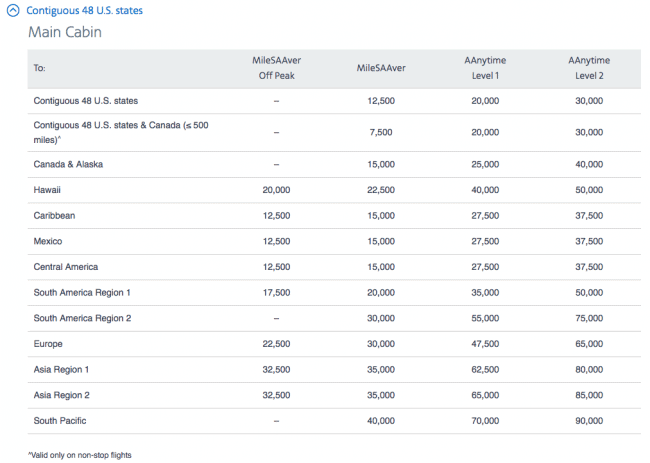
The chart for partners only has one price for each cabin because all partner awards price at the MileSAAver level.
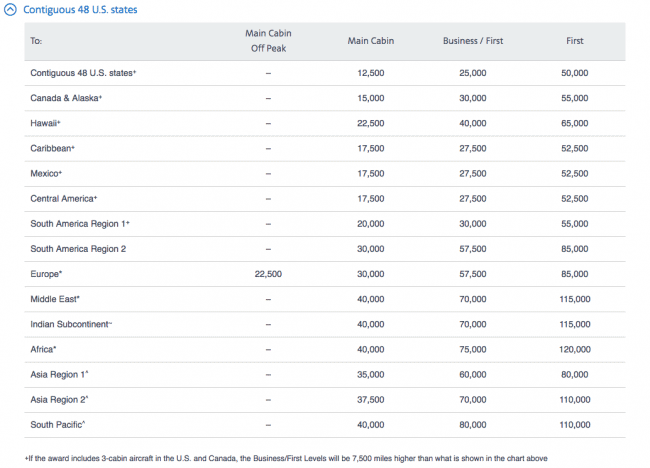
- The chart for an award with all American Airlines flights has economy Off Peak dates to several regions, while the partner chart only has economy Off Peak dates to Europe. To see economy Off Peak dates look at the American Airlines award chart, and click Details on Award Travel at the top. These are the current economy Off Peak dates:
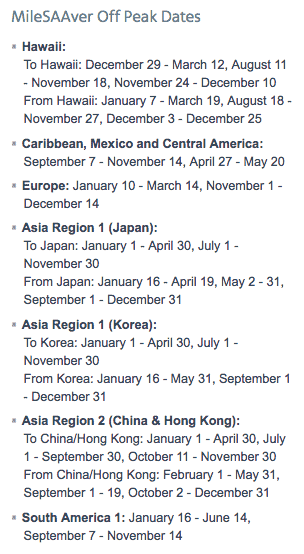
- The partner award chart covers all regions of the world while the AA-only chart has all awards starting or ending in North America. That makes sense since all American Airlines flights start or end in North America.
If you’ve found a direct flight, go read the price off the appropriate award chart. Otherwise, how does the award price? That’s where American Airlines’ award routing rules come into play.
American Airlines Award Routing Rules
If you find multiple flights you’re hoping to fit onto one award, can you? Yes, but if only if you follow the American Airlines award routing rules. If you don’t follow these rules, your trip will split into two or more awards, which will mean spending extra miles.
Some of these rules are unique to American Airlines, and several are obscure, but you need to know them to know how American Airlines’ award pricing works.
- Stopovers are not allowed on American Airlines awards.
- The airline that operates the flight that connects the two regions must have a published fare for your origin and destination city pair.
- Your trip must not exceed AA’s Maximum Permitted Mileage for your origin and destination by more than 25% as flown.
- Awards between Region A and Region B cannot transit Region C unless specifically allowed.
- An international award cannot consist of more than four segments. A domestic award cannot be more than three segments. These rules apply to one-ways, so roundtrips can have twice as many segments.
1. No Stopovers
The length of your connection is the time from the scheduled landing of your previous flight to the scheduled take off of your next flight.
On domestic awards, no connection can exceed four hours.
On international awards, no connection can exceed 24 hours. On international awards, your connections within the United States can be up to 24 hours.
Allowed
- Chicago to New York (23 hour connection)
- New York to Berlin (23 hour connection)
- Berlin to Madrid (destination)
This award would price out on the partner award chart as a single award between North America and Europe.
Not Allowed
- Chicago to New York (2 hour connection)
- New York to Berlin (3 day stopover)
- Berlin to Madrid (destination)
By “Not Allowed,” I just mean you can’t book the second trip as one American Airlines award. You could book it as two awards: Chicago to Berlin and Berlin to Madrid.
So what if you only have American Airlines miles, and you want to book a stopover on a roundtrip? Think about your trip as having three awards to two destinations.
In the example above, Chicago to Berlin is one award, Berlin to Madrid is another, and Madrid to Chicago is the third.
(In practice, Berlin to Madrid would be a poor-value American Airlines awards, so you’d want to book it with Avios or cash.)
2. Published Fare Rule
This is quite a unique rule: the airline that connects the two regions on your award must “publish a fare” from your origin to your destination.
“Publishing a fare” is a term of art. It does not necessarily mean the airline flies from your origin to your destination, just that they’ve “published a fare” for that origin and destination pair.
Example
You want to fly Melbourne to Los Angeles to New York to Baltimore. You found award space from Melbourne to Los Angeles on Qantas and on the last two legs on American Airlines. All your connections are under 24 hours.
Qantas is the region-connecting carrier because it flies the South Pacific-to-North America flight. Your origin is Melbourne and destination is Baltimore. Qantas must publish a fare from Melbourne to Baltimore for these flights to price as one award. Otherwise the trip will be split into two awards: Melbourne to New York and New York to Baltimore.
The easiest way to check whether an airline publishes a fare is to use the paid service Expert Flyer.
To see whether an airline has a published fare for an origin/destination city pair, once signed into Expert Flyer, click Fare Information.
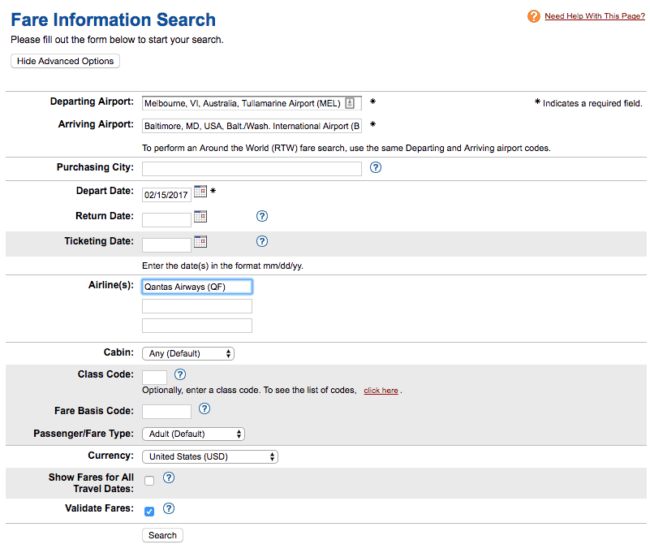
Fill out the form with your origin and destination city pair, pick a random date next month, and type in the airline you are checking.
After clicking search, hone in on the Airline column on the results page. You need to find at least one fare listed as being published by the two letter code of the airline you searched (Qantas = QF). (List of two letter codes.)
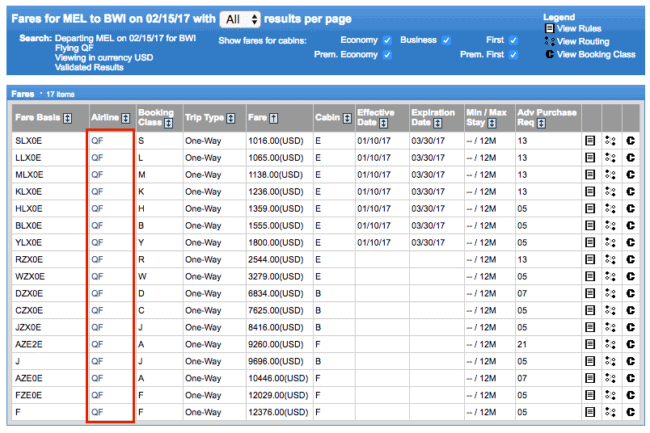
This search showed that Qantas does publish a fare from Melbourne to Baltimore though it most certainly doesn’t fly to Baltimore. That means the trip follows the published fare rule and as long as all the other rules are followed, it can be booked as one award from the South Pacific to North America.
Qantas is very good about publishing fares to obscure airports where it doesn’t fly, where even American Airlines doesn’t fly, like Roanoke, Virginia. Some AA partners aren’t so good. Etihad doesn’t publish fares to very many American cities, so to fly Etihad’s amazing First Class, you often need to book one award to a city where Etihad flies and then book the rest of the trip as a second award, increasing the miles price of your trip.
By the way, “YY” does not count as a published fare for any airline according to this rule.
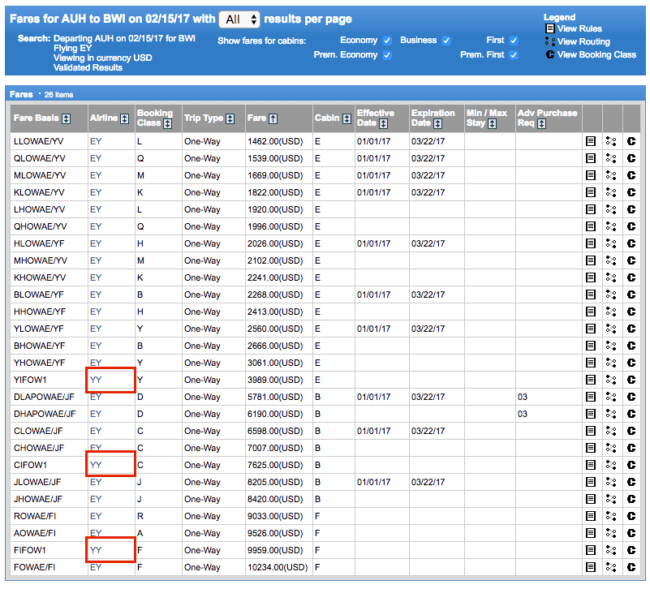
3. Maximum Permitted Mileage
Your trip must not exceed the Maximum Permitted Mileage for your origin and destination by more than 25% as flown.
Maximum Permitted Mileage (MPM) is another term of art. It is a number of miles that the airline puts on all city pairs for which it publishes a fare. MPM is not the direct distance between two cities; it is often a much larger number.
Again, I search MPM on Expert Flyer.
Example
Say you want to try this routing: Los Angeles to Boston to Tokyo to Taipei
First I would head to Expert Flyer, and I would look up the MPM for Los Angeles to Taipei on the Fare Information screen.
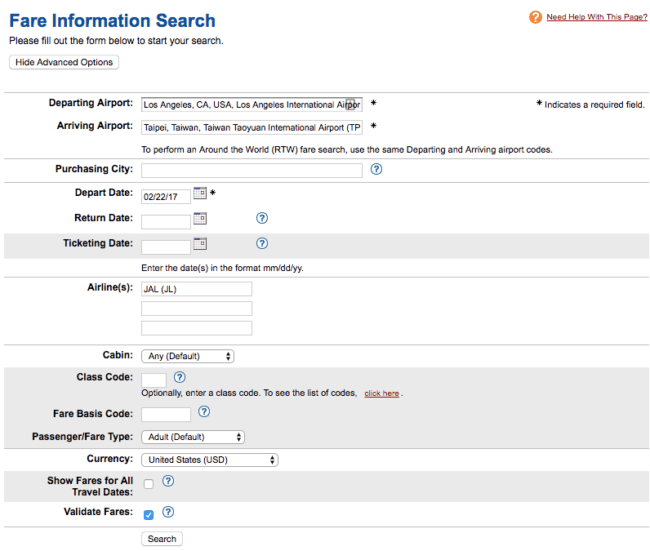
The results look like this. Click one of the icons in the I highlighted here with the yellow rectangle, on the right side of the screen.
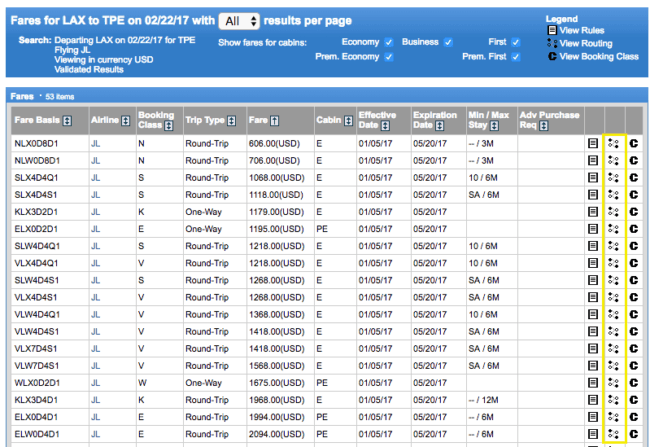
This takes you to the fare information, which lists the MPM.

Los Angeles to Taipei has an MPM of 8,137 miles. (Note that this is much farther than the direct distance between the two, which Great Circle Mapper lists as 6,799 miles.)
Multiply the MPM by 1.25, since we can exceed the MPM by 25% on American Airlines awards. That gets us to 10,171 miles, the maximum number of miles an American Airlines award from Los Angeles to Taipei can fly.
Go to Great Circle Mapper and check the distance of our putative routing including all connections. LAX-BOS-NRT-TPE is 10,669 miles, which exceeds the allowable 10,171, so this is not a valid routing.
The trip would break into two awards. Los Angeles to Boston plus Boston to Taipei, so it would cost more miles than if it were one valid award.
4. Region Transit Rule
Awards between Region A and Region B cannot transit Region C unless specifically allowed.
You need to fly directly from your region of origin to your region of destination without transiting any other regions– with a few exceptions.
Say you want to fly from New York to Melbourne. Your award can only include connections in North America and South Pacific, the regions of the origin and destination. It cannot connect in other regions like Asia 1 or Asia 2 (unless those regions are specified by American Airlines as allowable exceptions, and between North America and South Pacific, there are no exceptions; you have to fly direct.)
Here is a list of exception regions you can transit from the wiki in this flyertalk thread titled “oneworld other airlines award rules, information 2015 and on” which is almost complete.

The abbreviation QR stands for Qatar Airways.
And recently, American Airlines added the exception that you can transit Hong Kong flying between North American and the Indian Subcontinent. You can only fly Cathay Pacific or American Airlines to Hong Kong and only Cathay Pacific, SriLankan and Jet Airways between Hong Kong and the Indian Subcontinent when doing so.
You can see that there are very few exceptions, and some popular itineraries with other types of miles are not possible on a single American Airlines award:
- As I mentioned, you cannot transit Asia between North America and South Pacific. Your trip would break into two awards: North America to Asia 1 or 2 and Asia 1 or 2 to South Pacific.
- You cannot transit East Asia (Asia 1 and 2) between North America and the Middle East. Your trip would break into two awards: North America to Asia 1 or 2 and Asia 1 or 2 to the Middle East
- You cannot transit Central / South America Zone 1 between North America and South America Zone 2. Your trip would break into two awards: North America to South America Zone 1 and South America Zone 1 to South America Zone 2.
- And of course forget about transiting South America on your way to Australia or something fun like that!
Segment Limitation
An international award cannot consist of more than four segments. A domestic award cannot be more than three segments. These rules apply to one-ways, so roundtrips can have twice as many segments.
For example, the following is a legal award: Norfolk > Charlotte > Dallas > Bogotá > Lima.
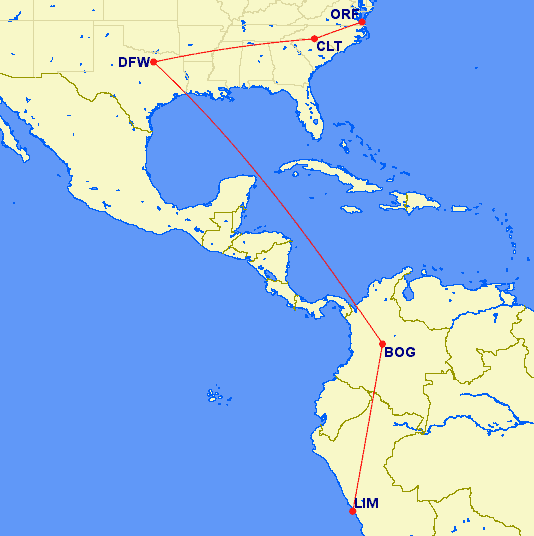
But Norfolk > Charlotte > Dallas > Bogotá > Lima > Cuzco is not, because it contains five segments.
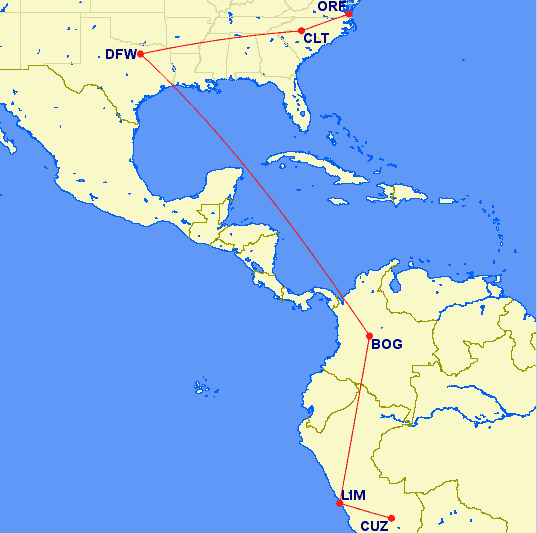
If you wanted to fly Norfolk > Charlotte > Dallas > Bogotá > Lima > Cuzco, you’d need to break off either the Norfolk > Charlotte segment or the Lima > Cuzco segment and pay for it as a separate award. It would be wiser to break off Norfolk > Charlotte as you’d spend 7.5k AAdvantage miles for that versus 10k for Lima > Cuzco.
Follow all the rules?
If you’ve followed all four rules, your trip should price as one award. Otherwise it will price as 2+ awards. How will your awards price?
- Every segment needs to be MileSAAver or partner for the award to price at the MileSAAver/partner price.
- If you have 1+ segment in First Class, that entire one way award prices at the First Class price.
- If you have no First Class and 1+ segment in Business Class, the award prices at the Business Class price. American Airlines considers American Airlines and Alaska Airlines domestic First Class to be Business Class (except on AA’s JFK-LAX and JFK-SFO services.)
Any questions?
Ways to Quickly Accrue AAdvantage Miles
- For a limited time, the Citi / AAdvantage Executive World Elite MasterCard is offering 75,000 bonus American Airlines miles for spending $7,500 within three months of opening the card
- The Barclaycard AAdvantage Aviator Red World Elite MasterCard is offering 50,000 bonus American Airlines miles after just one purchase and paying the annual fee of $95.
Citi also issue personal and business AAdvantage co-branded credit cards, but the sign up offers on both at the moment aren’t that great compared to what we’ve seen in the past. They both currently offer 30,000 miles for spending $1,000 on each card in three months. I would wait on one of those cards, as their sign up offers fluctuate.
Read Issuing Bank Rules for Approvals and New Bonuses before signing up for cards to plan your AAdvantage mileage accrual strategy.
Credit card links have been removed from posts and added to the menu bar at the top of every page of MileValue under the heading Top Travel Credit Cards.
Bottom Line
Knowing and understanding AAdvantage award rules will help you maximize your American Airlines miles. Bookmark this page for the next time you’re trying to piece together an advanced award.
Just getting started in the world of points and miles? The Chase Sapphire Preferred is the best card for you to start with.
With a bonus of 60,000 points after $4,000 spend in the first 3 months, 5x points on travel booked through the Chase Travel Portal and 3x points on restaurants, streaming services, and online groceries (excluding Target, Walmart, and wholesale clubs), this card truly cannot be beat for getting started!
Editorial Disclaimer: The editorial content is not provided or commissioned by the credit card issuers. Opinions expressed here are the author’s alone, not those of the credit card issuers, and have not been reviewed, approved or otherwise endorsed by the credit card issuers.
The comments section below is not provided or commissioned by the bank advertiser. Responses have not been reviewed, approved, or otherwise endorsed by the bank advertiser. It is not the bank advertiser’s responsibility to ensure all questions are answered.


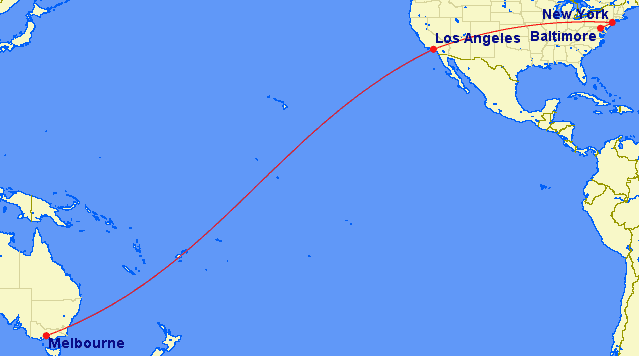

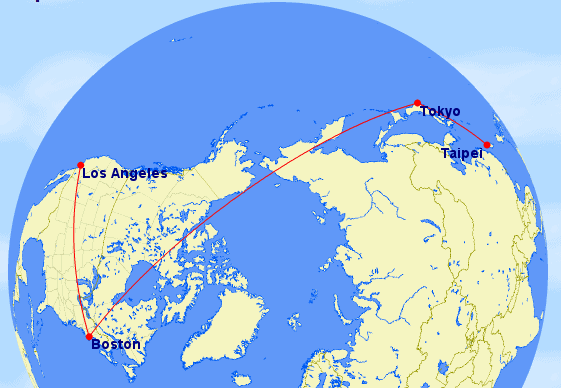

Terrific article. Really enjoying this series. Thanks!
Great!
Great Post! Is there any other way to find MPM without having to pay for a subscription?
I’m looking for the MPM forMLE-JTR.
If you could get that for me that would be great! If not, is the any exceptions to the MPM rule? Because MLE and JTR are both remote locations and Oneworld partners make a lot of connections.
My itinerary is looking like this:
MLE-AUH-LHR-JTR, or the other option being MLE-AUH-DOH-VIE-JTR. Thanks!
You can sign up for a free Expert Flyer trial. You can call AA and ask.
MLE-JTR 4836
I have found that there is an exception to the “no stopover” rule. That is when the last flight of the day from your home airport arrives in the connecting city too late to connect to your destination city that same day. You are allowed a stopover at the connecting airport and then first flight out the next day all on one award. I just successfully booked these awards taking advantage of the Citi reduced mile awards: Small midwest city-DFW-PBI; There will be an overnight at DFW. You do need to call to book awards this way as you cannot do this online (you need call anyway for the Citi reduced awards anyway). And initially the agent priced it out as 2 separate awards however I did ask about the last flight of the day exception and after a few minutes of checking with someone she priced it out as one award.
This is true.
I have US Airways 50k. Applied for a double pull on AA Citibank and was turned down for the business card as although great credit, they said I had too many new cards (6 in 6 months). Any advice on that?
Also, can I combine US and AA to fly to Cape Town South Africa and how?
US and AA will be automatically combined by June 30. We don’t know when. I guess you’ll have to wait and re-apply for business card.
mpm for del-ceb is 4066 miles.
according to aa 25% award rule: 4066 x 1.25= 5082 miles are allowed
i got a ticket issued del-kul-mnl-hkg-ceb which is 5722 (see great circle mapper) that is much more over the aa rule.
the airline connecting the two regions is malaysian airlines. but malaysian airlines doesnt have a published fare for del-ceb (see expertflyer)
the mpm is over the allowed 25% and malaysian airlines has no published fare for del-ceb.
how can it be possible that aa issued this ticket?
As one award? I don’t know. Congrats!
[…] That’s broader dates, the ability to fly partners, more countries, and a cheaper price. The American Airlines off peak awards and award chart in general is better than United’s. […]
[…] The First Class suite with a couch/bed and seat costs 90,000 American Airlines miles between the United States and the Middle East/India if Etihad releases award space. Even if you don’t live in New York, you can connect there in American Airlines First Class for zero extra miles on the award (assuming you are following the rules in this post.) […]
[…] Part 3 — Award Rules and How Many Miles You Need […]
[…] Part 3 — Award Rules and How Many Miles You Need […]
[…] Part 4 — Award Rules and How Many Miles You Need […]
[…] Part 4 — Award Rules and How Many Miles You Need […]
[…] Part 4 — Award Rules and How Many Miles You Need […]
[…] Part 4 — Award Rules and How Many Miles You Need […]
[…] you cannot connect in a third region on an American Airlines award between two regions, but you can connect in Doha between Australia and Europe without being charged for two awards. (If […]
[…] Part 4 — Award Rules and How Many Miles You Need […]
[…] Part 4 — Award Rules and How Many Miles You Need […]
[…] Part 4 — Award Rules and How Many Miles You Need […]
Question regarding the 24 hours connection time for MEL-LAX-JFK-BWI, I understand that less than 24 hours connection is allowed in LAX, what about in JFK airport? Is this 24 hours or the 4 hours rule applied as this is purely domestic connection. Thanks
The answer is in this post.
“On international awards, no connection can exceed 24 hours. On international awards, your connections within the United States can be up to 24 hours.”
Scott,
Is there an easy way to calculate the 331 days booking rule? A website i used showed that the last day for travel for 3/21/2016 is 2/15/2017. Your post shows 2/16/2017.
I’m trying my best to snag a travel date on right the last allowable moment before it devalues.
I might have miscounted. It might be 2/15.
How would a ticket from HKG to JFK with a connection in LHR be priced? Both legs in first on CX and BA
Thanks in advance!
HKG to LHR + LHR to JFK as this post explains (hopefully).
[…] Part 4 — Award Rules and How Many Miles You Need […]
Need some guidance for honeymoon planning using AA miles!
We are trying to leave NYC to South Africa on a safari during the holidays of 2016. As flights stand now we would not be able to arrive in JNB until Wens. 12/28 on a Qatar JFK-DOH-JNB routing in biz.
I found 2 biz class flights on Qatar from CDG to DOH on 12/25/16 and DOH to JNB on 12/26/16, but not sure if I can add in a JFK to CDG route as we will origin from New York. We could pay cash to get to Paris possibly but would prefer to use the award miles and not sure this routing would even be permissible (JFK-CDG-DOH-JNB).
Any help would be so greatly appreciated!!
That’s permissible. Whether there is space is the question.
[…] interesting ones: More exceptions will be added to the list of third regions you can transit. The MPM allowance may be […]
[…] cannot book this award space as part of a single award to India. That violates American Airlines routing rules, so your trip would be two awards: United States to Japan and Japan to […]
[…] The 90,000 mile price is the same whether you start in New York or anywhere else in North America to which Etihad publishes a fare, and the same whether you end in Abu Dhabi or anywhere else in the Middle East, Indian […]
[…] cannot book this award space as part of a single award to India. That violates American Airlines routing rules, so your trip would be two awards: United States to Japan and Japan to […]
[…] the next cheapest economy option to Europe in miles is spending 20,000 American Airlines during its off peak award window. But this 14,000 ThankYou Point price is available for travel any time of year as long as you […]
[…] Part 4 — Award Rules and How Many Miles You Need […]
[…] Can you do something similar with American Airlines miles? No, American Airlines awards cannot have any layovers longer than 24 hours. […]
Can you transit in middle east when traveling between N America and Asia 2 such as IAD-DOH-BKK
No, that’s not listed as an exception.
[…] Europe to Asia 2, American Airlines charges 90,000 miles each way in First Class. Ordinarily, on a single American Airlines award, you cannot transit the Middle East between Europe a…, but flying Qatar is an exception. If you book Paris to Doha to Bangkok on Qatar, it will price as […]
[…] Part 4 — Award Rules and How Many Miles You Need […]
Have you done a similar series on United miles? Your search engine did not come up with anything.
No, I haven’t. Maybe one day.
I’m glad you make the effort to go back and update these articles – they can be a real help at times. However, there is a (very) minor error in the article, in the last paragraph of section 2. Since the AA/US merger, AA now does fly to Roanoke.
[…] Part 4 — Award Rules and How Many Miles You Need […]
[…] Part 4 — Award Rules and How Many Miles You Need […]
[…] Part 4 — Award Rules and How Many Miles You Need […]
[…] Part 4 — Award Rules and How Many Miles You Need […]
Is the Citi card churnable?
I had the Citi an Barclay US air card at the same time. I canceled the Citi and kept the Barclay which is now Aviator Red. I’m going to cancel the Barclay next month before the fee comes due.
I’ll re-apply for the Citi after some time passes.
You can eventually get the Citi AAdvantage card again. Citi’s rule is as follows: You are only eligible to earn a sign up bonus if you haven’t opened or closed a card from the same type (brand or co-brand) within the last 24 months. So you’ll be eligible for it again 24 months after you closed your old one.
The CitiBusiness AAdvantage is considered a different product in this regard, so whether you have a Citi AA personal card or closed one doesn’t affect your eligibility for it.
[…] Buenos Aires, Argentina > Bogotá, Colombia (overnight in Bogotá, but the connection was less than 24 hours so segments priced as one award) […]
[…] Part 4 — Award Rules and How Many Miles You Need […]
Just FYI – using Avios on US Mainland to South America Region 2 only costs 25k miles vs the 30k reported by AA and in the partner chart above.
That chart lists prices in American Airlines miles (not Avios) to fly partner airlines.
Understood. I’m referring to the section that calls this out:
“(In practice, Berlin to Madrid would be a poor-value American Airlines awards, so you’d want to book it with Avios or cash.)”
It would also make sense to use Avios when going to SAz2 following this same logic.
Oh I see. Yes indeed, as long as the distance flown issn’t longer than 5,500 miles, it would cost less Avios than AA miles to fly to Southern South America in AA economy.
Are the partner mile redemptions listed *only* for non-stop flights? For example, if I wanted to fly from Louisville to Rio de Janeiro, the partner rate listed in 30k miles (when available as seen on BA.com). However, does that only include the route from MIA to GIG or will the code share from LOU to MIA to GIG also apply as long as the flight is booked on the LATAM code? (note: this means the LOU to MIA is AA metal).
My home airport is San Diego. I try to find Milesavers from SAN or LAX to EZE (Buenos Aires) but they almost NEVER have any milesaver awards. But they almost always have availability to GRU (Sao Paulo). Would the best and lowest use of miles be to book to GRU. And then use Avios (if you have Avios points) to book from GRU to EZE?
Or what other suggestions would you have to use AAdvantage miles to get from SAN to EZE with the lowest possible miles. I also have some miles with British Airways Avios as well. Thanks!
LAX-GRU for 20k miles + GRU-EZE is hardly a savings over the 30k AA miles you could use to book all of that as one award (AA + LATAM flights) and the latter has the advantage of being on one ticket in case of irregular operations.
Once again Love ur Library ..What I really like about AA is u can change the DATEs (only) of ur travel if they have award flts for that time slot for FREE done that a few times ..1/18 AA Hawaii has been change once may change again depending on funds ..Lots of AA points great option to have..
CHEERs
[…] If redeeming AA miles, you can add a segment to anywhere in the United States that American Airlines or Alaska Airlines flies without changing that 80k price (San Francisco is a Alaska hub with tons of destinations). For a refresher on AAdvantage award routing rules, check out Redeem American Airlines Miles: Part 4, Award Rules & How Many Miles You Need. […]